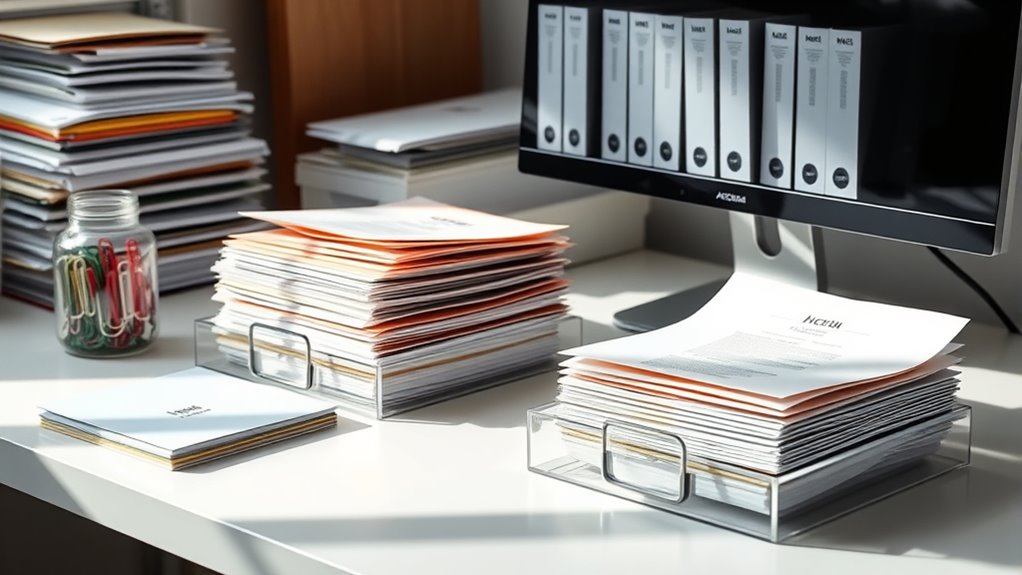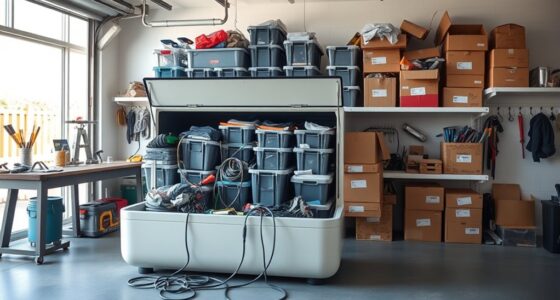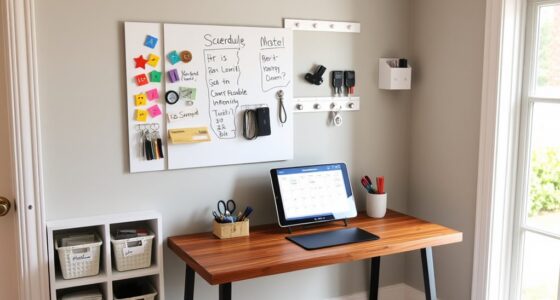To conquer paper clutter, set up a dedicated mail zone near your entry or workspace. Personalize your process by sorting mail twice daily—discard junk, set action items aside, and file important documents. Scan and digitize records to reduce physical storage, and use a consistent digital filing system for easy access. Automate sorting where possible to save time. Continue exploring these tips to discover how a simple workflow can keep your space organized and clutter-free.
Key Takeaways
- Designate a specific spot for incoming mail to streamline sorting and prevent clutter buildup.
- Process mail regularly, immediately handling actionable items and digitizing documents for easy access.
- Develop a consistent digital filing system with clear labels and categorized folders to facilitate quick retrieval.
- Automate sorting with email rules and document scanning apps to reduce manual effort and maintain organization.
- Regularly review and clean digital archives to ensure security, prevent clutter, and keep workflows efficient.

Ever wondered how to streamline your email management process? If paper clutter has become a persistent problem, transforming your workflow can make a huge difference. The key lies in developing an efficient “Mail to Archive” system that minimizes clutter while ensuring important documents are stored securely and easily accessible. Instead of letting paper piles grow or wasting time searching through stacks, you can set up a process that automatically manages your mail and digital documents, freeing up your space and mental clarity.
First, create designated spots for incoming mail. Place a tray or inbox near your door or workspace where all mail lands immediately. Make it a habit to process this stack at specific times—say, twice a day. When you handle your mail, sort it quickly: toss out junk, set aside items that need action, and identify documents that should be archived. This routine prevents mail from piling up and reduces the chance of overlooking important papers.
For the items requiring action, take care of them right away. Pay bills online, respond to invitations, or file the necessary documents in your digital archive. For papers that are purely for record-keeping, use a scanner or a mobile scanning app to digitize them. Digitization eliminates the need for physical storage and makes retrieval straightforward. Once scanned, discard the physical copy unless it’s legally required to keep the original. This approach keeps your workspace tidy and ensures that your documents are backed up digitally, reducing the risk of loss.
Implement a consistent filing system for your digital archives. Use clear labels and folders categorized by type—financial, medical, legal, or personal. This way, when you need a document, you’ll know exactly where to find it without rummaging through stacks. Regularly review and clean out your digital files to prevent clutter from creeping back in. A good rule is to archive or delete files that are no longer relevant annually, keeping your system lean and efficient.
Automation tools can make this process even easier. Set up rules in your email client to automatically sort incoming messages into folders, or use apps that scan and categorize documents as they arrive. With these tools, you spend less time manually sorting and more time focusing on what truly matters. Developing a disciplined Mail to Archive workflow reduces paper clutter, saves time, and creates a more organized environment. Additionally, being aware of the rising trend in payment data protection can help you safeguard your digital documents against breaches. Once you get into the habit, managing your mail becomes effortless rather than overwhelming, giving you a clearer space—and peace of mind.
Frequently Asked Questions
How Often Should I Review My Archived Papers?
You should review your archived papers at least once a year to guarantee everything is still relevant and organized. Regular reviews help you identify outdated documents, update records, and declutter unnecessary files. If you handle sensitive or important papers, consider checking them more frequently, like every six months. Staying consistent with your review schedule keeps your archive manageable, saves time, and ensures you have quick access to important information when needed.
What Digital Tools Can Assist in Archiving Workflows?
You can use digital tools like Evernote, Notion, or OneNote to streamline your archiving workflows. These apps let you scan, organize, and tag documents effortlessly, making retrieval simple. Cloud storage services like Dropbox or Google Drive also help you securely store and access papers from anywhere. Automate your process with scanning apps like CamScanner or Adobe Scan, which turn physical documents into searchable digital files, ensuring your archive stays organized and accessible.
How Do I Handle Sensitive or Confidential Documents?
You should handle sensitive documents with care by storing them in encrypted digital folders or secure cloud services that offer robust security features. Always limit access to authorized personnel, use strong passwords, and enable two-factor authentication. Regularly back up these files to secure locations, and consider physical safeguards like locked cabinets for paper copies. Consistently follow your organization’s confidentiality protocols to protect sensitive information effectively.
Can I Automate Parts of the Mail to Archive Process?
Yes, you can automate parts of your mail to archive process. Setting up smart filters and rules in your email client helps you swiftly sort and send messages to specific folders. You can also use automation tools to scan, categorize, and archive physical documents. This saves you time, reduces manual tasks, and keeps your workflow flowing smoothly. Embrace automation to efficiently manage your mail, making clutter a thing of the past.
What Are Best Practices for Labeling Archived Papers?
You should use clear, consistent labels that include the date, category, and a brief description for each archived paper. Keep labels simple and legible, using a uniform format or color coding to easily identify contents. Place labels on the top or side of folders, and consider using digital labels or barcodes for automated systems. Regularly review and update labels to make certain they stay accurate and helpful.
Conclusion
By adopting the mail to archive workflow, you’ll drastically reduce paper clutter and reclaim your space. Studies show that the average person spends over 12 hours annually searching for misplaced documents—imagine saving that time! With a streamlined process, you can quickly sort, scan, and archive your mail, making your workspace more efficient and less stressful. Take control of your paper chaos today, and enjoy the clarity and productivity that comes with an organized system.









